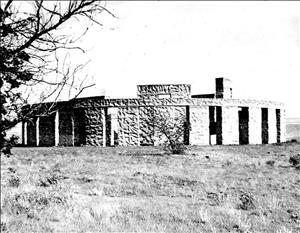On July 4, 1918, the altar stone of what will be a reinforced-concrete replica of England's ancient Stonehenge is dedicated at Maryhill. The replica will be built to memorialize Klickitat County soldiers killed in World War I. Attending the dedication are businessman and philanthropist Sam Hill (1857-1931), Seattle City Engineer R. H. Thomson (1856-1949), University of Washington professor Edmond Meany (1862-1935), Klickitat County War Council chairman Nelson B. Brooks, many dignitaries from Seattle and Portland, and hundreds of Klickitat County residents. Dedicated while the war is still being fought, it is the first American memorial to those who died in what was supposed to be "the war to end all wars." The memorial will be completed in 1929.
Bloody Sacrifices
Sam Hill had visited Stonehenge on England's Salisbury Plain with Lord Horatio Herbert Kitchener (1850-1916) in 1915. Kitchener was Britain's Secretary of State for War at the time and it was supposedly he who told Sam Hill, "Here the ancients 4,000 years ago offered bloody sacrifices to their heathen gods of war" (Tuhy, p. 190). At the time it was generally thought that Druids had constructed Stonehenge as a place for human sacrifice. This idea has since fallen out of favor (some archeologists believe Stonehenge functioned as an astronomical calendar), but it had a powerful impact on Hill at the time. A Quaker and lifelong pacifist, Hill reasoned that modern warfare (like Druid sacrifices as he understood them) was a form of needless human sacrifice. Hill's biographer John Tuhy quotes Hill as later saying that he built the Maryhill Stonehenge "to remind my fellow man of [that] incredible folly" (p. 190).
Hill asked Professor W. Wallace Campbell (1862-1938) of the Lick Observatory, who was in Goldendale to observe a total eclipse of the sun visible there on June 8, 1918, to decide where the altar stone should be positioned. The stone's placement and the plan for where the standing pillars would later be located were based on Campbell's calculations of where sunrise would be on the summer solstice.
The Goldendale Sentinel reported:
"To Klickitat County, Washington attaches the distinction of being the first community in the Northwest and so far as reported the first in America, to consecrate a memorial to its sons who have met death while in the nation's service in the existing war ... six names have already been inscribed upon the monument: Dewey V. Bromley, John W. Cheshier, James B. Duncan, Robert F. Graham, Carl A. Lester, and Robert F. Venable. Space has been left for others who are expected in the nature of things to follow. Of these, 'One sleeps in the land where rolls the Oregon,' said Nelson B. Brooks, who made the chief dedicatory address, 'three in the soil of the pioneered hills of Klickitat, one upon the blood-stained hills of France, and one who, when the ocean gave up its dead from the torpedoed Tuscania, found a brutal place beneath the heather of Scotland' " (July 11, 1918).
The inscription on the altar stone read "To the memory of the soldiers and sailors of Klickitat County who gave their lives in defense of their country ... in the hope that others inspired by the example of their valor and their heroism may share in that love of liberty and burn with that fire of patriotism which death alone can quench" (Goldendale Sentinel, July 11, 1918).
The Maryhill Stonehenge alter stone became a sort of war memorial in progress. By the November 11, 1918, armistice the names of seven more Klickitat County men had joined the fallen: Louis Leidl, Harry Gotfredson, Edward Lindblad, Evan Childs, Charles Auer, James Henry Allyn, and William Clary.
Standing Stones
The completed monument was dedicated on May 30, 1929. Sited on a bluff overlooking the Columbia River, the monument consists of two concentric circles of pillars. The 40 inner circle pillars are each 9 feet high, and the outer 30 pillars are each 16 feet high. In the center of the circle are five trilithons (two upright stones supporting a third stone that bridges them) of varying heights. The altar stone is 6 by 18 feet high. The Maryhill Stonehenge is a full-scale replica, meant to reflect how England's Stonehenge probably appeared just after its construction, with pillars standing tall.
The pillars at Stonehenge in England are hewn from stone. The pillars at Maryhill Stonehenge were cast in reinforced concrete, the building material Hill also used for the structure that became the Maryhill Museum and for his Seattle home.
Originally Hill planned to use local stone to build the memorial, but this did not prove possible. The concrete of which Maryhill Stonehenge is formed was given a rough, stone-like texture by lining the wooden concrete molds with crumpled tin.
The War That Did Not End All Wars
In 1995, the Klickitat County War Memorial Project Committee raised $37,500 to refurbish the memorial, repairing the effects of wind and weather. The altar stone and columns were capped and patched, loose concrete and rusting rebar were removed, graffiti was scrubbed off, and a permanent weather coating was applied. A new memorial honoring Klickitat County residents who died in World War II, the Korean War, and the Vietnam War was constructed nearby. The new memorial and the refurbished Stonehenge were dedicated on August 22, 1995.
Maryhill Museum Director Josie De Falla told the Columbian that the new memorial "assists in communicating what Sam Hill, a Quaker, felt so fervently: that it was imperative that future generations never lose sight of the loss of life, as well as the heroism and valor, which result from war" (July 30, 1995).

